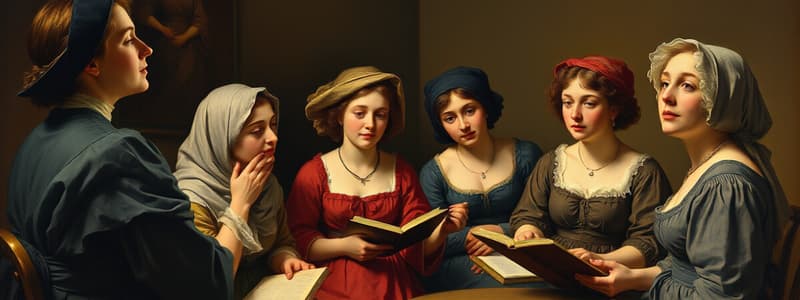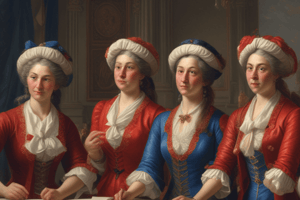Podcast
Questions and Answers
What was a major goal of women's clubs formed during the 18th and 19th centuries?
What was a major goal of women's clubs formed during the 18th and 19th centuries?
- To support male-dominated political movements
- To achieve socio-political rights for men
- To address social injustices and engage in public life (correct)
- To promote traditional gender roles within society
Which document, authored by Elizabeth Cady Stanton and Lucretia Mott, marked the beginning of the women's rights movement?
Which document, authored by Elizabeth Cady Stanton and Lucretia Mott, marked the beginning of the women's rights movement?
- The Declaration of Sentiments (correct)
- The Declaration of Independence
- The Equal Rights Amendment
- The Bill of Rights
Why were some early feminists opposed to the Equal Rights Amendment (ERA)?
Why were some early feminists opposed to the Equal Rights Amendment (ERA)?
- They believed it was unnecessary for women's rights
- They thought it would diminish women's progress in the workforce (correct)
- They were concerned about backlash from anti-feminist groups
- They felt it distracted from more pressing issues like education
What initiative did Carrie Chapman Catt advocate for in the women's suffrage movement?
What initiative did Carrie Chapman Catt advocate for in the women's suffrage movement?
What significant political event occurred in 1920 in relation to women's rights?
What significant political event occurred in 1920 in relation to women's rights?
Study Notes
Women's Role in Society
- The 18th and 19th centuries promoted the idea of separate spheres for women and men, limiting women's societal roles.
- Women's clubs emerged to combat social injustices and sought solutions to various societal problems.
Focus Areas of Women's Clubs
- Initially concentrated on education, eventually addressing issues such as temperance, housing, and the food and drug industry.
- These clubs facilitated the expansion of roles for middle-class women, enabling them to engage in public life.
Contributions to Women's Suffrage Movement
- Women’s clubs provided leadership experience and organizational skills vital for the suffrage movement.
- The right to vote was a central goal, with organized efforts driving public engagement among women.
Seneca Falls Convention
- The 1848 Seneca Falls Convention marked the official beginning of the women's rights movement.
- The Declaration of Sentiments, written by Elizabeth Cady Stanton and Lucretia Mott, was presented at this historic event.
Perspectives on Equal Rights Amendment (ERA)
- Some early feminists opposed the ERA, believing it might undermine existing gains for women in the workforce.
Key Figures
- Carrie Chapman Catt advocated for local organization and state-level suffrage initiatives.
- Despite President Wilson's lack of support for women's voting rights, the 19th Amendment was ratified in 1920.
Legacy of the 19th Amendment
- The 19th Amendment, granting women the right to vote, is also known as the Susan B. Anthony Amendment, in honor of the prominent suffrage leader.
Studying That Suits You
Use AI to generate personalized quizzes and flashcards to suit your learning preferences.
Description
This quiz explores the role of women's clubs during the 18th and 19th centuries in challenging the notion of separate spheres for men and women. Discover how these organizations addressed various social injustices, including education, temperance, and housing issues. Test your knowledge of this pivotal movement in women's history.





